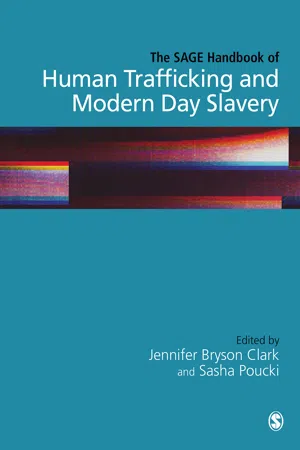
The SAGE Handbook of Human Trafficking and Modern Day Slavery
- 584 pages
- English
- ePUB (mobile friendly)
- Available on iOS & Android
The SAGE Handbook of Human Trafficking and Modern Day Slavery
About This Book
Millions of people around the world are forced to work without pay and under threat of violence. These individuals can be found working in brothels, factories, mines, farm fields, restaurants, construction sites and private homes: many have been tricked by human traffickers and lured by false promises of good jobs or education, some are forced to work at gunpoint, while others are trapped by phony debts from unscrupulous moneylenders.
The SAGE Handbook of Human Trafficking and Modern-Day Slavery provides a comprehensive, interdisciplinary and global look at the diverse issues surrounding human trafficking and slavery in the post-1945 environment. Covering everything from history, literature and politics to economics, international law and geography, this Handbook is essential reading for academics and researchers, as well as for policy-makers and non-governmental organisations
Frequently asked questions
Information
Part I Defining Contemporary Slavery
1 Conceptualizing the Exploitation of Human Trafficking
Trafficking in persons’ shall mean the recruitment, transportation, transfer, harbouring or receipt of persons,by means of the threat or use of force or other forms of coercion, of abduction, of fraud, of deception, of the abuse of power or of a position of vulnerability or of the giving or receiving of payments or benefits to achieve the consent of a person having control over another person,for the purpose of exploitation. Exploitation shall include, at a minimum, the exploitation of the prostitution of others or other forms of sexual exploitation, forced labour or services, slavery or practices similar to slavery, servitude or the removal of organs.3
- compelling to perform work or services, by use of force, threats or other forms of coercion, in violation of the legal provisions connected to labour conditions, remuneration, health and security;
- slavery, use of certain practices similar to slavery, or resorting to other ways of deprivation of liberty;
- compelling to engage in prostitution, to participate in pornographic performances, with a view to the production, distribution and any introduction into circulation of such performances, the acquisition, sale or possession of pornographic material, or practicing other forms of sexual exploitation;
- compelling harvesting of organs or tissues for transplantation or collection of other component parts of the human body;
- using a woman as a surrogate mother or for reproductive purposes;
- abuse of a child's rights with a view to illegal adoption;
- use in armed conflicts or in illegal military formations;
- use in criminal activities;
- compelling to engage in begging;
- sale to another person;
- compelling to engage in other activities that violate fundamental human rights and freedoms.5
Conceptualizing Exploitation
Table of contents
- Cover
- Half Title
- Editorial Board
- Title Page
- Copyright Page
- Contents
- List of Figures and Tables
- Notes on the Editors and Contributors
- Introduction
- Part I Defining Contemporary Slavery
- 1 Conceptualizing the Exploitation of Human Trafficking
- 2 The International Legal Framework on Human Trafficking: Contemporary Understandings and Continuing Confusions
- 3 Assessing the Global Slavery Index
- 4 Empirical Research on Sex Work and Human Trafficking in SE Asia and a Critique of Methodologies for Obtaining Estimates of Human Trafficking Numbers
- Part II Forms of Human Trafficking and Contemporary Slavery
- 5 Labour Trafficking
- 6 Practices of Bonded Labour in India: Forms of Exploitation and Human Rights Violations
- 7 The Evolving Concept of Worst Forms of Child Labor
- 8 Organ Trafficking: Transplant Tourism and Trafficking in Persons for the Removal of Organs
- Part III The Context of Human Trafficking and Contemporary Slavery
- 9 The Business of Modern Slavery: Management and Organizational Perspectives
- 10 Human Trafficking, Sexual Slavery, and Extremism
- 11 Human Trafficking, Modern Day Slavery and Organized Crime
- 12 Migration and Trafficking: The Unintended Consequences of Security and Enforcement Frameworks and the Revictimization of Vulnerable Groups
- Part IV Interdisciplinary Approaches to Human Trafficking and Contemporary Slavery
- 13 A Survivor-Centric Approach: The Importance of Contemporary Slave Narratives to the Anti-Slavery Agenda
- 14 Trafficking in Human Beings: The Convergence of Criminal Law and Human Rights
- 15 Pretty Vacant: Stolen Girls and Girlhoods in Anti-Trafficking Discourses
- 16 Indigenous Women in Trafficking: Links Between Race, Ethnicity and Class1
- Part V Case Studies
- 17 Identification of Trafficking Victims in Europe and the Former Soviet Union
- 18 Commercial Sexual Exploitation and Sex Trafficking of Children in the West African Region
- 19 Identifying Human Trafficking Victims Under the Sharia Law in Iran
- 20 Impacts of Cultural Practices in Anti-Trafficking Policies in Southeast Asia
- 21 Human Trafficking in North America
- 22 Legal Yet Enslaved: The Case of Migrant Farm Workers in the United States
- 23 Australia's Response to Human Trafficking Nationally and Regionally: The Question of Impact
- 24 Child Workers: An Ugly Face in the Labour Industry
- Part VI Ending Contemporary Slavery
- 25 The International Law Enforcement Community: Cooperative Efforts in Combatting Human Trafficking
- 26 Identification, Rescue, and Social Intervention with the Victims of Trafficking for Sexual Exploitation in Spain1
- 27 Organizational Configurations in the Provision of Social Services and Advocacy to Victims and Survivors of Human Trafficking
- 28 Contemporary Social Movements to End Slavery – NGOs and Beyond
- Index